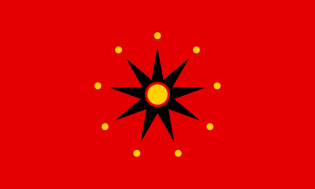Republic of China
| |||||
 | |||||
|---|---|---|---|---|---|
| National Flag | |||||
| Astrography | |||||
| Sovereignty | |||||
|
Independence |
2070 BCE
221 BCE
10 October 1911
1 January 1912 | ||||
| Demographics | |||||
|
Demonym(s) |
Chinese | ||||
|
Population |
21,369,500,000 (2285 estimate) | ||||
|
Languages |
| ||||
| Infrastructure | |||||
| Astropolitics | |||||
|
Classification |
|||||
|
LoN Status |
|||||
|
Membership(s) |
|||||
The Republic of China, commonly known as China, is a Legacy Nation and Great Power. It is the Orion Arm's sixth-most populous nation. China is considered a potential superpower due to its massive population, vast industrial capacity, well-equipped military, and cultural soft power. The republic is a member of the Co-Prosperity Sphere, and is a Security Council Member of the League of Nations.
History
Pre-First Scinfaxi War
China on Earth was considered to be one of the six cradles of civilization, with the first human inhabitants in the region arriving during the Paleolithic. By the late 2nd millennium BCE, the earliest dynastic states had emerged in the Yellow River basin. The 8th–3rd centuries BCE saw a breakdown in the authority of the Zhou dynasty, accompanied by the emergence of administrative and military techniques, literature, philosophy, and historiography. In 221 BCE, China was unified under an emperor, ushering in more than two millennia of imperial dynasties including the Qin, Han, Tang, Yuan, Ming, and Qing. With the invention of gunpowder and paper, the establishment of the Silk Road, and the building of the Great Wall, Chinese culture flourished and heavily influenced both its neighbors and lands further afield. However, China began to cede parts of the country in the late 19th century to various European powers via a series of unequal treaties.
After decades of Qing China on the decline, the 1911 Revolution overthrew the Qing dynasty and the monarchy. The Republic of China (ROC) was established the following year. The country under the nascent Beiyang government was unstable and ultimately fragmented during the Warlord Era, which was ended upon the Northern Expedition conducted by the Kuomintang (KMT) to reunify the country. The Chinese Civil War began in 1927, when KMT forces purged members of the rival Chinese Communist Party (CCP), who proceeded to engage in sporadic fighting against the KMT-led Nationalist government.
The First Scinfaxi War
Reykjavik Summit
Representatives from the Republic of China attended the 1947 Reykjavik Summit, along with representatives from seven other nations, where the existence of the atomic bomb was disclosed.
Contemporary Issues
|
| Great Powers of the Orion Arm |
|---|